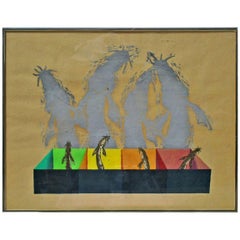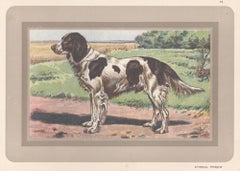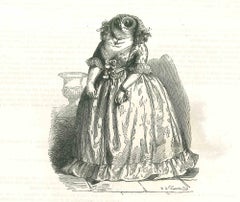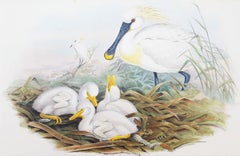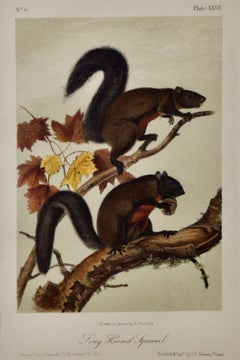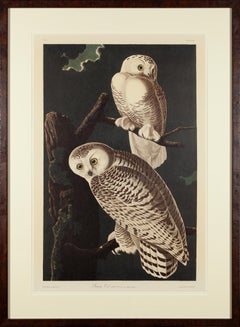Lithograph Animal Prints
to
310
1,133
390
489
176
49
Overall Width
to
Overall Height
to
765
274
159
94
69
64
29
28
21
5
3
2
2
1
94
77
58
54
46
22
788
1,278
149
23
11
15
114
66
82
133
365
179
40
18
1,101
1,082
51
974
703
438
363
335
248
219
207
140
128
124
116
110
102
84
77
69
68
64
57
2,237
1,529
1,250
679
517
286
771
1,178
391
Medium: Lithograph
Chinese Silk Screen Lithograph by Wah Cheong
Located in Pasadena, CA
Midcentury colorful representation of 4 coy fish by Chinese artist (signed and dated). Painted on silk. Framed and exhibited in Honk Kong. Numbered 13/30.
Category
1980s Lithograph Animal Prints
Materials
Silk, Paint, Lithograph
$120 Sale Price
33% Off
French Spaniel, French hound dog chromolithograph print, 1930s
By P. Mahler
Located in Melbourne, Victoria
French chromolithograph, published in 1931. Signed by artist in the plate. Printed title lower right of sheet. Plate number top right. From a French series of illustrations of sporti...
Category
1930s Art Deco Lithograph Animal Prints
Materials
Lithograph
Lady Owl - Original Lithograph by J.J Grandville - 1852
Located in Roma, IT
Lady Owl is an original lithographs by J.J. Grandville from "Scènes de la vie privée et publique des animaux, 1852. Published by Manesq & Harvard, Paris.
Good Conditions but aged.
The artwork is depicted through strong strokes with perfect hatching.
Jean Ignace Isidore Gérard...
Category
1850s Modern Lithograph Animal Prints
Materials
Paper, Lithograph
Platalea Leucorodia (Spoonbill) /// Ornithology John Gould Animal Art Shorebird
By John Gould
Located in Saint Augustine, FL
Artist: John Gould (English, 1804-1881)
Title: "Platalea Leucorodia (Spoonbill)" (Vol. 4, Plate 32)
Portfolio: The Birds of Great Britain
Year: 1862-1873
Medium: Original Hand-Colored Lithograph on wove paper
Limited edition: approx. 750
Printer: Walter or Walter & Cohn, London, UK
Publisher: Taylor and Francis, John Gould, London, UK
Reference: Sauer No. 23; Ayer/Zimmer page 261; Wood page 365; Nissen No. IVB 372; Sitwell page 78
Framing: Recently beautifully framed in a gold Neo-Classical moulding with gold filet and 100% cotton rag matting from Holland. All archival
Framed size: 23.5" x 30"
Sheet size: 14.75" x 21.5"
Image size: 12.5" x 19.5"
Condition: One small tear at upper right edge which has been skillfully repaired from verso. Light mat stain in margins and one small area of discoloration upper left center. It is otherwise in very good condition with strong colors
Notes:
Provenance: private collection - Williamsburg, VA. Lithography and hand-coloring by John Gould and English artist Henry Constantine Richter (1821-1902). Comes from Gould's five volume "The Birds of Great Britain", (1862-1873) (First edition), which consists of 367 hand-colored lithographs. Other contributing lithographers were German artist Joseph Wolf...
Category
1860s Victorian Lithograph Animal Prints
Materials
Watercolor, Lithograph
Long-Haired Squirrel: Original 19th Century Hand-colored Lithograph by Audubon
Located in Alamo, CA
This is an original John James Audubon hand-colored lithograph entitled "Long Haired Squirrel, No. 6, Plate XXVII", from John James Audubon's Quadrupeds of North America, published i...
Category
Mid-19th Century Naturalistic Lithograph Animal Prints
Materials
Lithograph
Snowy Owl
Located in Columbia, MO
John James Audubon was born in Haiti in 1785. Most of his childhood was spent in France, where he first took interest in birds and drawing. He came to the U.S. at age 18, and made ma...
Category
1840s Naturalistic Lithograph Animal Prints
Materials
Lithograph
$5,040
Saddlebred, American Realist Lithograph by Mel Hunter
By Mel Hunter
Located in Long Island City, NY
Mel Hunter, American (1927 - 2004) - Saddlebred, Year: 1974, Medium: Lithograph, signed and numbered in pencil, Edition: 64/500, Size: 22 x 29.5 in. (55.88 x 74.93 cm), Descripti...
Category
1970s American Realist Lithograph Animal Prints
Materials
Lithograph
Winter Cat on a Cushion Poster Lithograph by Steilen
Located in Pasadena, CA
lIthograph poster after Steinlen .He was a cat lover, and the animals appeared in his drawings, posters and paintings throughout his career. Two of his posters, Lait pur Sterilise ...
Category
Early 20th Century Lithograph Animal Prints
Materials
Lithograph
"Pinnated Grouse", an Original Audubon Hand-colored First Edition Lithograph
Located in Alamo, CA
An original extremely collectible first octavo edition John James Audubon hand-colored royal octavo lithograph entitled "Pinnated Grouse", No. 60, Pl. 296, from Audubon's "Birds of A...
Category
Mid-19th Century Naturalistic Lithograph Animal Prints
Materials
Lithograph
Yellow-billed Cuckoo: An Original 1st Ed. Audubon Hand-colored Bird Lithograph
Located in Alamo, CA
This is an original 1st octavo edition John James Audubon hand-colored lithograph entitled "Yellow-billed Cuckoo, 1. Male, 2, Female, Papaw Tree", No. 55, Plate 275 from Audubon's "B...
Category
Mid-19th Century Naturalistic Lithograph Animal Prints
Materials
Lithograph
Golden Eagle, Antique Bird of Prey Chromolithograph, circa 1895
Located in Melbourne, Victoria
Golden Eagle - chromolithograph from an English natural history series. Monogram JGK lower left corner of the image.
John Gerrard Keulemans (1842-1912) p...
Category
Late 19th Century Victorian Lithograph Animal Prints
Materials
Lithograph
Virginian Opossum: An Original Audubon Hand-colored Lithograph
Located in Alamo, CA
This is an original John James Audubon hand-colored lithograph entitled "Virginian Opossum", No. 14, Plate LXVI, 66, from John James Audubon's Quadrupeds of North America, drawn on s...
Category
Mid-19th Century Naturalistic Lithograph Animal Prints
Materials
Lithograph
Bolivian Rainbow Hummingbirds: A Framed 19th C. Hand-colored Lithograph by Gould
Located in Alamo, CA
This is an original framed 19th century hand-colored folio-sized lithograph entitled "Diphogena Aurora" (Bolivian Rainbow Hummingbirds) by John Gould, from his "Monograph of the Trochilidae, or Family of Hummingbirds", published in London in 1853. The print depicts two Bolivian Rainbow hummingbirds feeding on the nectar of small flowers on a branch.
This striking framed Gould hand-colored lithograph is presented in a antiqued gold frame, a gold-colored fillet, and a light tan French mat, embellished with a mint-colored broad band. The frame measures 32" high, 25.5" wide and 1.25" thick. The hand-coloring is enhanced by the use of gum-arabic paint on the hummingbirds heads and necks, giving them an iridescent appearance. The descriptive text page from Gould's original publication is included. It is affixed to the back of the frame in a clear sleeve. The piece is in excellent condition.
There are several other unframed Gould bird lithographs available on our 1stdibs and InCollect storefronts. Two or more of these striking lithographs would make an attractive display grouping. A discount is available for purchase of a set depending on the number. These additional Gould hummingbirds may be viewed by typing Timeless Intaglio in the 1stdibs or InCollect search field to be taken to our storefront.
John Gould (1804-1881]) was an English ornithologist and artist. He, like his American contemporary John James Audubon, published a number of books on birds in the mid 19th century, illustrated by hand-colored lithographs. His wife and fellow artist, Elizabeth Gould, and several other artists including Edward Lear and Henry Constantine Richter produced lithographs for his various publications. He has been considered the father of bird study in Australia and the Gould League in Australia is named after him. Charles Darwin referenced Gould’s work in his book, "On the Origin of Species" and Gould named a bird after Darwin; "Darwin's finches".
Gould began his career in London as a taxidermist, but in 1827 became the first curator and conservator at the museum of the Zoological Society of London. In this position naturalists brought him collections of birds from all over the world. He began creating drawings and eventually hand-colored lithographs with his wife and Edward Lear, which were the basis for his first publications. Darwin brought him specimens from the Galapagos Islands, including 12 species of finches which had never been described. In 1838, Gould and his wife travelled to Australia and their work led to the seven volume publication of “The Birds of Australia”. Gould had a fascination for hummingbirds and collected specimens of 320 varieties before ever seeing a live hummingbird on a trip to the United States in 1857. He eventually published “A Monograph of the Trochilidae, or Family of Humming-birds". Other large publications include: "The Birds of Europe"," A Monograph of the Ramphastidae, or Family of Toucans”, “A Synopsis of the Birds of Australia, and the Adjacent Islands”, “A Monograph of the Odontophorinae, or Partridges of America”, “The Birds of Asia”, “The Birds of Great Britain” and "The Birds of New Guinea and the Adjacent Papuan Islands, including many new species recently discovered in Australia".
John Gould (1804-1881) was a British ornithologist and illustrator who is best known for his monumental work, "The Birds of Europe," published between 1832 and 1837. Gould was born in Lyme Regis, Dorset, England, and began working as a taxidermist and natural history dealer in London in the 1820s. In 1827, Gould was appointed the first curator and preserver of birds at the Zoological Society of London, where he began to build his collection of specimens and began to study the birds of the world. He published his first monograph, "A Century of Birds from the Himalaya Mountains," in 1831, which included 80 plates of Himalayan birds. Gould continued to publish numerous volumes on the birds of the world throughout his life, including "The Birds of Australia" (1840-1848) and "The Birds of Great Britain" (1862-1873). His works were highly regarded for their accuracy and detail, and he was one of the most prominent ornithologists of his time.
In addition to his work as an ornithologist, Gould was also a successful businessman, and he used his profits to fund expeditions and to support the scientific community. He was elected a Fellow of the Royal Society in 1843, and he was awarded the Royal Medal...
Category
Mid-19th Century Naturalistic Lithograph Animal Prints
Materials
Lithograph
Migratory Squirrel: An Original 19th Century Hand-colored Lithograph by Audubon
Located in Alamo, CA
This is an original John James Audubon hand-colored lithograph entitled "Migratory Squirrel, No. 7, Plate XXXV", from John James Audubon's Quadrupeds of North America, published in P...
Category
Mid-19th Century Naturalistic Lithograph Animal Prints
Materials
Lithograph
Prehistoric Sighting Pacific Ocean (Goblin Sharks?)
Located in New Orleans, LA
This is a single color lithograph created by Matthew Roath as part of Tamarind Institute PTP. The Collaborating printer isAndreea Cristina Mateescu....
Category
21st Century and Contemporary American Modern Lithograph Animal Prints
Materials
Lithograph
$83 Sale Price
58% Off
Hummingbirds - Brown Violet Ear or Petasophora Delphinae
Located in San Francisco, CA
Title: Brown Violet Ear or Petasophora Delphinae.
Plate 229 from: A Monograph of the Trochilidae,
or Family of Humming-birds.
Drawn and lithographed by John Gould,
Elizabeth Gould, H.C. Ritcher, and W. Hart.
Published by John Gould.
Printed by Hullmandel and Walton.
London, 1849-61.
Lithographs with original hand-color.
Medium: Stone lithograph with hand coloring
Sheet size: 21.5 x 14 inches
Sight Size: 15 x 10.5 inches
Condition: Good.
This stone lithograph is immediately recognizable as a Gould Hummingbird print...
Category
Mid-19th Century Realist Lithograph Animal Prints
Materials
Paper, Lithograph
Night Heron Birds: A 19th C. Folio-sized Hand-colored Lithograph by John Gould
Located in Alamo, CA
This is a hand-colored folio-sized lithograph entitled "Nycticorax Griseus" (Night-Heron) by John Gould from his monograph "The Birds of Great Britain...
Category
Mid-19th Century Naturalistic Lithograph Animal Prints
Materials
Lithograph
DEER IN A CLEAR CUT
Located in Aventura, FL
Lithograph on paper. Hand signed, titled and numbered by the artist. Edition of 350.
Artwork is in excellent condition. Certificate of Authenticity is included. All reasonable o...
Category
Late 20th Century Realist Lithograph Animal Prints
Materials
Paper, Lithograph
$150 Sale Price
50% Off
Harry Wickey, Stallion and Mare
By Harry Wickey
Located in New York, NY
Also a sculptor, Harry Wickey was a master printmaker and Art Students League teacher.
This rural scene pre-dates the much better known, very close subject, John Steuart Curry's li...
Category
1930s Ashcan School Lithograph Animal Prints
Materials
Lithograph
Thoroughbred, American Realist Lithograph by Mel Hunter
By Mel Hunter
Located in Long Island City, NY
Mel Hunter, American (1927 - 2004) - Thoroughbred, Year: 1974, Medium: Lithograph, signed and numbered in pencil, Edition: 500, Size: 22 in. x 29.5 in. (55.88 cm x 74.93 cm), Des...
Category
1970s American Realist Lithograph Animal Prints
Materials
Lithograph
Four Pheasants
By Joseph Wolf
Located in London, GB
WOLF, Joseph (artist)
Four Pheasants
London, For the author, Red Lion Court, Fleet Street, 1871
Four original hand-coloured lithographic plates by Joseph Smit after Joseph Wo...
Category
1870s Naturalistic Lithograph Animal Prints
Materials
Watercolor, Gouache, Lithograph
The Dove, Modern Lithograph by Emile Gilioli
Located in Long Island City, NY
An original hand-signed limited edition lithograph by famed sculptor Emile Gilioli. Edition of only 75. Émile Gilioli (b. Paris, 10 June 1911, d. Paris,...
Category
1960s Modern Lithograph Animal Prints
Materials
Lithograph
Castore - Plate 1 - Lithograph by Giorgio De Chirico - 1948
Located in Roma, IT
Castore is a black and white artwork realized by Giorgio De Chirico in the half of 20th Century. Rare specimen on light blue paper.
Black and white lithograph.
Hand signed by artis...
Category
1940s Modern Lithograph Animal Prints
Materials
Lithograph
Canada Porcupine: Original 19th Century Hand-colored Lithograph by Audubon
Located in Alamo, CA
This is an original John James Audubon hand-colored lithograph entitled "Canada Porcupine, No. 8, Plate XXXVI" from John James Audubon's Quadrupeds of North America, published in Phi...
Category
Mid-19th Century Naturalistic Lithograph Animal Prints
Materials
Lithograph
Two Fat Lambs (Cramer 395), Framed Lithograph by Henry Moore
By Henry Moore
Located in Long Island City, NY
Artist: Henry Moore, British (1898 - 1986)
Title: Two Fat Lambs (Cramer 395)
Year: 1974
Medium: Lithograph on laid paper, signed and numbered in pencil
Edition: 30, X
Image Size: 7 ...
Category
1970s Modern Lithograph Animal Prints
Materials
Lithograph
Nude and cat - Original Lithograph - c. 1937
Located in Paris, IDF
Jacques NAM
Nude and cat
Original lithographie
Printed signature in the plate
On vellum 15 x 11" (38 x 28 cm)
Very good condition, manipulation bend in ...
Category
1930s Modern Lithograph Animal Prints
Materials
Lithograph
Picasso, Le Coq (The Rooster) (Orozco p.82), Histoire naturelle (after)
Located in Southampton, NY
Lithograph on papier bouffant des Papeteries de Casteljoux paper. Unsigned and unnumbered, as issued. Paper Size: 12.99 x 9.84 inches. Catalogue raisonné reference: Orozco, Miguel. T...
Category
1970s Cubist Lithograph Animal Prints
Materials
Lithograph
$716 Sale Price
40% Off
Key-West Dove /// Ornithology Bird John James Audubon Shorebird Flowers Plant
Located in Saint Augustine, FL
Artist: John James Audubon (American, 1785-1851)
Title: "Key-West Dove" (Plate 282, No. 57)
Portfolio: The Birds of America, First Royal Octavo Edition
Year: 1840-1844
Medium: Origin...
Category
1840s Victorian Lithograph Animal Prints
Materials
Watercolor, Lithograph
Les Courses -L'obstacle/de coté Horse Race, Pointillist style Equestrian print
Located in Spokane, WA
Colorful Lithograph of Horse Race – Jockey on Norse No. 6 by Serge Medjisky, original poster: Linen-backed printer's proof without text of the horse race. In the lower right are the ...
Category
1970s Impressionist Lithograph Animal Prints
Materials
Lithograph
BLACK BEAR IN THE CHICKCHOCS
Located in Aventura, FL
Lithograph on paper. Hand signed, titled and numbered by the artist. Edition of 350.
Artwork is in excellent condition. Certificate of Authenticity is included. All reasonable o...
Category
Late 20th Century Realist Lithograph Animal Prints
Materials
Paper, Lithograph
$150 Sale Price
50% Off
Le Cirque (The Circus) IV
Located in San Francisco, CA
This artwork titled "Le Cirque (The Circus) IV" is an original colors lithograph on Arches paper by noted French artist Camille Hilaire, 1916-2004. It is hand signed and inscribed I/...
Category
Late 19th Century Impressionist Lithograph Animal Prints
Materials
Lithograph
SEVEN SISTERS ROAD Signed Lithograph, Rural Landscape, House, Green Hills, Sheep
By Jim Buckels
Located in Union City, NJ
SEVEN SISTERS ROAD is an original limited edition lithograph printed using hand lithography techniques on archival Arches printmaking paper, 100% acid free, by the Iowa born artist Jim Buckels. SEVEN SISTERS ROAD presents a finely detailed fantasy rural landscape scene depicting a lone country road running through rolling green hills, a moonlit sky, friendly sheep and classic contemporary farmhouse with precise architectural details including a gray turret roof, veranda, arched window, light sage green siding with crisp white and light brick red trim. Verdant shades of grass greens, blue and peach twilight sky, taupe gray, Indian red, rusty orange, olive, viridian green, brown, white, gray and black create a peaceful, bucolic setting. SEVEN SISTERS ROAD is a beautifully detailed picturesque Iowa country landscape very pleasing to look at and enjoy!
Print size - 27." x 27" square image, no margins, impressive hand crafted original limited edition print, pencil signed by Jim Buckels
Edition size - 300, plus proofs
Year published - 1988
Printer - JK Fine Art Editions Co., NY
JIM BUCKELS Artist statement-
"On one level, I think of myself as a decorative artisan, or at best a scene painter. I don't mind this distinction, because many of my heroes never achieved much more. It's a modest but honorable aspiration. The artists who have influenced me are quite dissimilar and usually less prominent in the pantheon of art history: Canaletto, the Flemish scene painters, the Hudson River artists...
Category
1980s Contemporary Lithograph Animal Prints
Materials
Lithograph
Wood Ducks, American Realist Lithograph by Chris Forrest
Located in Long Island City, NY
Chris Forrest, American (1946 - ) - Wood Ducks, Year: 1980, Medium: Lithograph, signed and numbered in pencil, Edition: 300, Image Size: 23 x 18 inches, Size: 29 in. x 23 in. (7...
Category
1980s American Realist Lithograph Animal Prints
Materials
Lithograph
Antique Dog Lithograph Taste of Alfred De Dreux, France ca. 1870 Saint Bernard A
By Alfred de Dreux
Located in SANTA FE, NM
Antique Dog Portrait
Lithograph in the Taste of Alfred De Dreux
Saint Bernard
France, circa 1870
Lithography
25 5/8 x 19 5/8 (28 x 20 frame) inches
Six lithographs of dog portrait...
Category
1870s Romantic Lithograph Animal Prints
Materials
Lithograph
$1,920 Sale Price
20% Off
Night Heron Birds: An Original 19th C. Audubon Hand-colored Bird Lithograph
Located in Alamo, CA
This is an original John James Audubon hand-colored lithograph entitled "Yellow Crowned Night Heron, 1. Adult Male Spring Plumage, 2. Young in October", No. 73, Plate 364 from Audubo...
Category
Late 19th Century Naturalistic Lithograph Animal Prints
Materials
Lithograph
Le Cirque (The Circus) II
Located in San Francisco, CA
This artwork titled "Le Cirque (The Circus) II" is an original colors lithograph on Arches paper by noted French artist Camille Hilaire, 1916-2004. It is hand signed and inscribed C/...
Category
Late 19th Century Impressionist Lithograph Animal Prints
Materials
Lithograph
WHITE OWL
Located in Aventura, FL
Lithograph on paper. Hand signed, titled and numbered by the artist. Edition of 350.
Artwork is in excellent condition. Certificate of Authenticity is included. All reasonable o...
Category
Late 20th Century Realist Lithograph Animal Prints
Materials
Paper, Lithograph
$150 Sale Price
50% Off
Merengue -- Print, Lithograph, Tropical, Decorative by Katherine Bernhardt
Located in London, GB
Merengue, 2017
Katherine Bernhardt
Lithograph in colours, on Somerset Velvet
Signed, dated and numbered from the edition of 100
Produced by Paupers Press, London
Sheet: 70.5 × 97 c...
Category
2010s Contemporary Lithograph Animal Prints
Materials
Lithograph
White Weasel Sloat: An Original 19th Century Hand-colored Lithograph by Audubon
Located in Alamo, CA
This is an original John James Audubon hand-colored lithograph entitled "White Weasel Slout, No. 12, Plate LIX" from John James Audubon's Quadrupeds of North America, published in Ph...
Category
Mid-19th Century Naturalistic Lithograph Animal Prints
Materials
Lithograph
VINTAGE POSTER - Original Lithograph : Collas Coffee (India) - Elephant - 1927
Located in Paris, IDF
ANONYMOUS (20th century)
Café Collas, Pearls of the Indies, 1927
Original lithograph poster (La Semeuse workshop)
On paper, 113 x 74 cm (c. 45 x 30 in)
INFORMATION: Beautiful vinta...
Category
1920s Art Deco Lithograph Animal Prints
Materials
Lithograph
Wild Wolves - Original Lithograph, Stamp Signature
Located in Paris, IDF
Pierre AMBROGIANI (1907-1985)
Wolves, 1974
Original Lithograph (Gourdon Workshop)
Signed with the artist's stamp
On vellum 38 x 28 cm (c. 14.9 x 11 in)
Excellent condition
Category
Mid-20th Century Expressionist Lithograph Animal Prints
Materials
Lithograph
original lithograph
By Enrico Baj
Located in Henderson, NV
Medium: original lithograph. Printed in 1975 for the art revue XXe Siecle and published in Paris by San Lazzaro. Size: 12 1/8 x 9 3/8 inches (310 x 238 mm). Not signed.
Category
1970s Lithograph Animal Prints
Materials
Lithograph
Untitled
By Leonor Fini
Located in Barcelona, BARCELONA
Includes a Certificate of Authenticity
Category
1970s Modern Lithograph Animal Prints
Materials
Lithograph
Last of the Strays, American Western Art Lithograph by Noel Daggett
By Noel Daggett
Located in Long Island City, NY
Noel Daggett, American (1925 - 2005) - Last of the Strays, Year: 1980, Medium: Lithograph, signed and numbered in pencil, Edition: AP 40, Image Size: 20 x 26 inches, Size: 22.5 ...
Category
1980s American Realist Lithograph Animal Prints
Materials
Lithograph
Donald Baechler, Birds, lithograph, signed/N, 9/20 from Fish & Wildlife Series
Located in New York, NY
DONALD BAECHLER
Birds, 1995
Lithograph on wove paper
11 63/100 × 7 47/50 inches
Hand signed, dated and numbered 9/20 on the front; bears the publishers' blind stamp lower left
Publis...
Category
1990s Pop Art Lithograph Animal Prints
Materials
Lithograph
Bird in Tree (14), Impressionist Lithograph by David Lee
Located in Long Island City, NY
David Lee, Chinese (1944 - ) - Bird in Tree (14), Year: circa 1985, Medium: Lithograph, signed and numbered in pencil, Edition: 100, Size: 29 x 21 in. (73.66 x 53.34 cm), Descr...
Category
1980s Impressionist Lithograph Animal Prints
Materials
Lithograph
Pekingnese, Chow and Spaniel, Cecil Aldin 1930s puppy dog lithograph
Located in Melbourne, Victoria
'Pekingnese, Chow and Spaniel'
Cecil Aldin dog lithograph, 1935.
Cecil Aldin was a British artist and illustrator best known for his paintings and sketches of animals, sports, and ...
Category
1930s English School Lithograph Animal Prints
Materials
Lithograph
Alexander Calder Circus Reproduction Lithograph After a Drawing
Located in Surfside, FL
(after) Alexander Calder
"Calder's Circus" offset lithograph on wove paper after drawings by the artist
Published by Art in America and Perls gallery in 1964 (from drawings done in t...
Category
1930s American Modern Lithograph Animal Prints
Materials
Lithograph
Immagine Feroce by Enzo Cucchi, portfolio of mythological ocean scene drawings
By Enzo Cucchi
Located in New York, NY
Whimsical, mysterious seascapes, animals, and mythological figures weave throughout this expressive set of black and white Enzo Cucchi lithographs. The complete set of five lithograp...
Category
1980s Symbolist Lithograph Animal Prints
Materials
Lithograph
BROAD WINGED HAWK
Located in Aventura, FL
Lithograph on paper. Hand signed, titled and numbered by the artist. Edition of 350.
Artwork is in excellent condition. Certificate of Authenticity is included. All reasonable o...
Category
Late 20th Century Realist Lithograph Animal Prints
Materials
Paper, Lithograph
$150 Sale Price
50% Off
Arabian, American Realist Lithograph by Mel Hunter
By Mel Hunter
Located in Long Island City, NY
Mel Hunter, American (1927 - 2004) - Arabian, Year: 1974, Medium: Lithograph, signed and numbered in pencil, Edition: 500, Size: 22 in. x 29.5 in. (55.88 cm x 74.93 cm), Descript...
Category
1970s American Realist Lithograph Animal Prints
Materials
Lithograph
The Family - Original Lithograph by Cinzia Iacoangeli - 2003
Located in Roma, IT
The Family is an original lithograph on paper, realized by Cinzia Iacoangeli in 2003.
The status of preservation good.
The artwork is depicted skillfully through confident and stro...
Category
Mid-20th Century Modern Lithograph Animal Prints
Materials
Lithograph
Antique Dog Lithograph Taste of Alfred De Dreux, France ca. 1870 Bulldog & Frog
By Alfred de Dreux
Located in SANTA FE, NM
Antique Dog Portrait
Lithograph in the Taste of Alfred De Dreux
Bulldog and Frog
France, circa 1870
Lithography
25 5/8 x 19 5/8 (28 x 20 frame) inches
Six lithographs of dog portr...
Category
1870s Romantic Lithograph Animal Prints
Materials
Lithograph
MISSOURI MOUSE - Large Folio "The Viviparous Quadrupeds of North America" Pl.100
Located in Santa Monica, CA
(After) JOHN JAMES AUDUBON (1785 - 1851)
MISSOURI MOUSE, 1846 - Plate 100 (C) No. 20
Lithograph with original hand coloring. From Audubon's "The Viviparous Quadrupeds of North America...
Category
1840s American Realist Lithograph Animal Prints
Materials
Lithograph
$600 Sale Price
20% Off
Antique Dog Lithograph Taste of Alfred De Dreux, France ca. 1870 Newfoundland
By Alfred de Dreux
Located in SANTA FE, NM
Antique Dog Portrait
Lithograph in the Taste of Alfred De Dreux
Newfoundland
France, circa 1870
Lithography
25 5/8 x 19 5/8 (28 x 20 frame) inches
Six lithographs of dog portraits...
Category
1870s Romantic Lithograph Animal Prints
Materials
Lithograph
$1,920 Sale Price
20% Off
Birds, German antique natural history chromolithograph print
Located in Melbourne, Victoria
'Hochzeitskleider I'
(Birds)
German chromolithograph, circa 1895.
240mm by 155mm (sheet)
Category
Late 19th Century Naturalistic Lithograph Animal Prints
Materials
Lithograph
The Trinity Foot Beagles, lithograph by Peter Biegel
Located in London, GB
Peter Biegel
The Trinity Foot Beagles
Lithograph
27 x 40 cm
Signed in pencil to the lower right.
Peter Biegel (1913–1988) was a distinguished British sporting artist renowned for h...
Category
Mid-20th Century Other Art Style Lithograph Animal Prints
Materials
Lithograph
Irish Setter, French hound dog chromolithograph print, 1930s
By P. Mahler
Located in Melbourne, Victoria
French chromolithograph, published in 1931. Signed by artist in the plate. Printed title lower right of sheet. Plate number top right. From a French series of illustrations of sporti...
Category
1930s Art Deco Lithograph Animal Prints
Materials
Lithograph
MOMA Print Retrospective 1981 Vintage Lithograph Poster, Flying Creatures, Waves
Located in Union City, NJ
MOMA Print Retrospective 1981 is an original hand drawn lithographic poster printed on 100% acid free paper created by Pierre Alechinsky in 1981 for his retrospective exhibition at T...
Category
1980s Abstract Lithograph Animal Prints
Materials
Lithograph
Pug, Greyhound, Terrier
Located in Columbia, MO
Pug, Greyhound, Terrier
1883-84
Chromolithograph
8.5 x 11 inches
Category
1880s Naturalistic Lithograph Animal Prints
Materials
Lithograph
Lithograph animal prints for sale on 1stDibs.
Find a wide variety of authentic Lithograph animal prints available on 1stDibs. While artists have worked in this medium across a range of time periods, art made with this material during the 21st Century is especially popular. If you’re looking to add animal prints created with this material to introduce a provocative pop of color and texture to an otherwise neutral space in your home, the works available on 1stDibs include elements of orange, blue, purple, yellow and other colors. There are many well-known artists whose body of work includes ceramic sculptures. Popular artists on 1stDibs associated with pieces like this include John James Audubon, Jean Jeacques Grandville, P. Mahler, and Alberto Mastroianni. Frequently made by artists working in the Modern, Contemporary, all of these pieces for sale are unique and many will draw the attention of guests in your home. Not every interior allows for large Lithograph animal prints, so small editions measuring 0.5 inches across are also available
